Insect & Disease Conditions Update
Forest & Shade Tree - Insect & Disease Conditions for Maine
July 21, 2015
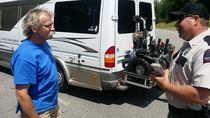 Independence Day Weekend Firewood Ban Enforcement
The Forest Protection Division of the Maine Forest Service is a key partner in educating the public about invasive forest insects. In an event dubbed “Operation Bug Watch” Forest Rangers inspected vehicles registered from outside Maine for firewood during the busy Independence Day weekend. Information regarding the threat of untreated firewood to our forests and specifics regarding some of the invasive pests it can carry was provided to visitors.
Rangers made more than 600 inspections during the event. Many visitors reacted favorably to the effort. One notable response was: “I am glad to see you guys doing this, because you don't want what we have in our state.” Untreated firewood from out-of-state is banned to reduce the risk of spreading destructive, invasive forest pests such as emerald ash borer, Asian longhorned beetle, brown spruce longhorned beetle and others.
Photo: Ranger Ritchie Hafford speaks with a visitor from Alabama about firewood and invasive species at the Medway rest area. (Photo: MFS, Forest Protection)
|
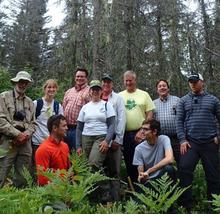 Spruce Budworm Field Tour: July 10th -12th
Maine Forest Service entomologists Charlene Donahue and Allison Kanoti participated in a spruce budworm tour conceived by Baxter State Park’s Scientific Forestry Management Area Resource Manager Eben Sypitkowski and Advisory Committee Member Gordon Mott. The group of Maine managers and scientists was hosted by Alain Dupont, Director of Forestry and Environment Division of SOPFIM; Robert Johns, Canadian Forest Service Researcher and Daniel Arsenault, Irving Woodlands Forester. Gordon and Virginia Mott spent a weekend planning the tour with Alain and Rob in late June, and graciously invited MFS entomologist Colleen Teerling for that trip.
On July 10th, some of the group toured portions of the Black Brook District of Irving Woodlands. There they observed white and black spruce plantations and weevil-resistant Norway spruce plantations and discussed intensive management approaches and various strategies for diversifying forest regeneration and structure.
|
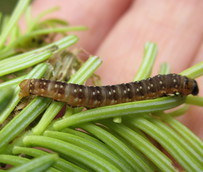 The largest part of the tour was a full day on the north shore of the Saint Laurence Seaway with more than a dozen stops between Forestville and Baie-Comeau, QC. Saturday’s well-planned stops included observations of a variety of conditions including stands treated with Bt and those left untreated, observation of damage on fir and spruces, observations of budworm impacts in different soil moisture regimes in untreated stands and a tour of the Baie-Comeau field laboratory.
Sampling and management tactics were discussed. A variety of budworm life stages were present: Bt-killed and sickened larvae were observed as were healthy 6th-instar larvae; pupae were abundant; and moths were emerging, mating and depositing eggs.
The tour concluded on Sunday with stops in the Matapédia Valley en route to Maine. There, in June, Gordon Mott had spotted what he suspected budworm damage. By July, the damage was unmistakable—with reddened foliage ringing the host trees and larvae, pupae and moths observed.
Participants agreed that this was among the most valuable field tours they had ever attended. That sort of quality does not happen by chance. Recognition is due to the hosts and organizers for all the work they put into developing the tour and to the participants for their thoughtful interactions throughout.
Photo 1: Spruce budworm tour organizers, leaders and participants in front of damaged untreated fir—outbreak began 2006 (Gordon Mott, Allison Kanoti, Eben Sypitkowski, Brian Roth, Charlene Donahue, Jensen Bissell, Joe Wiley, Austin Bragdon, Alain Dupont, Rob Johns). (Photo: Virginia Mott )
Photo 2: Late instar spruce budworm larva, June 20, 2015 (Photo: C. Teerling, MFS)
|
Insects
Browntail Moth (Euproctis chrysorrhoea) – Reports of large congregations of adult browntail moths beneath lights have been coming in from heavily infested areas of the state such as Freeport, Brunswick and Bath. People are seeing some of the biggest aggregations of adults in recent memory. This is consistent with the building populations reported in April. It is too late to control browntail moth for this season—but it is not necessarily the end of browntail rash season. The toxin in the caterpillar hairs is stable and can remain a hazard for a number of years. Read more about how to avoid “browntail rash” and manage the pest in our browntail moth factsheet.
Emerald Ash Borer (Agrilus planipennis) – Emerald ash borer (EAB) has not yet been found in the state of Maine. However, because of new finds in New Hampshire, Belknap County, NH (north of previously quarantined counties) has been quarantined. This is roughly at the same latitude as the town of Acton in York County, ME. See www.nhbugs.org for more information on the quarantine expansion.
In Maine, purple traps have been hung throughout the state. We are currently checking them for EAB and changing the lures. You can read more about the trap program on our website. Biosurveillance for EAB has started for the 2015 season. Again, no EAB have been found so far.
Given the current known distribution of EAB relative to Maine’s borders it is too early to be using pesticides to treat for the pest anywhere in the state. That doesn’t mean it is too early to read up on the methods one might use to treat ash trees. The insecticide guideline from the North Central IPM Center is available on-line.
 European Pine Sawfly (Neodiprion sertifer) – An impressive population of European pine sawfly was reported from Brunswick (Cumberland County). This species usually attacks previous-year foliage of pine trees—it prefers Mugho, Scots, red and jack pines, but can feed on others. Often with sawflies, the larvae are not seen until significant feeding and development has occurred—usually too late for management. This was the case in Brunswick. The larvae were already near full-sized and were wandering. This University of Minnesota Extension website has a nice summary of common sawflies and their management.
Photo: A mass of wandering European pine sawfly. (Photo: Fred Woodbury)
|
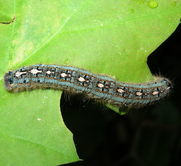 Forest Tent Caterpillar (Malacosoma disstria)– Forest tent caterpillars have been reported from Ashland and Island Falls (Aroostook County), Topsham and Woolwich (Sagadahoc County). This is one of several hairy caterpillars that people often lump with gypsy moth. It is a distinctive, hairy blue-tinged caterpillar which can be recognized by the line of white to off-white “footprints” along the center of their backs. Many guides call those spots “keyholes”, but it is easy to remember that: FOrest tent has FOotprints.
Forest tent caterpillar is an outbreak-prone species. The increase in sightings may indicate the populations are building. This is one of the light trap network targets—once the light-trap catches have been turned in and sorted we’ll have a better idea of what is happening with the forest tent caterpillar population.
Photo: Late instar forest tent caterpillar with a line of footprint-shaped spots down its back. (Photo: C. Donahue, MFS )
|
Hemlock Woolly Adelgid (Adelges tsugae) – The predatory beetle Sasajiscymnus tsugae was released on a private woodlot in Woolwich in June. The woodlot is a large property protected from development; forest management is allowed. The hemlocks grow in a mix with white pine as well as oak and other hardwoods. Understory hemlock are vigorous; overstory are mature large-sawlog-sized trees. The property is located near the Kennebec River, which will be an important corridor for movement of both the adelgid and the predators.
Towards the beginning of August hemlock woolly adelgid crawlers will be settled on their hosts and wedded to them for the next six months or more. Because the adelgid cannot be spread except on rooted hosts, now is an ideal time to conduct forest management and pruning activities in hemlock.
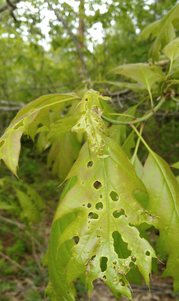 Oak Leaf Shothole Leafminer (Agromyza viridula) – Several cases of damage by the oak leaf shothole leafminer fly have been noted this year. The pattern of damage is such that this can be mis-diagnosed as winter moth or Bruce spanworm feeding damage. Usually pictures suffice to identify the fly damage. Most often what people note are the Swiss-cheese-like holes that develop after the adult female fly punctures the folded leaves of the host (oaks) with her ovipositor. The female feeds on the sap that comes out of the puncture-wound and oviposits in some punture sites. Less frequently, the larval mines are also present. Feeding between the epidermal layers of the leaf causes necrotic patches to develop. Samples or photos were observed from Bar Harbor and Hancock (Hancock County) on red oak and Presque Isle (Aroostook County) and York (York County) on white oak.
Photo: Shothole damage on red oak caused by Agromyzid fly; June Hancock Co. (Photo: Stephen MacDonald)
|
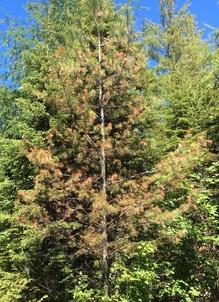 Pine Leaf Adelgid (Pineus pinifoliae) – Pine leaf adelgid is a native insect that requires both spruce and white pine to complete its life cycle. Damage to spruce is mostly aesthetic; damage to pine can lead to significant growth reduction and mortality. There was a region-wide outbreak of this insect between 1953 and 1963 which led to some white pine mortality in Maine. Currently, white pine in parts of Maine are experiencing outbreak populations of this pest. The most severe damage appears to be west of Baxter State Park, with damaged overstory and understory white pine noted in aerial survey, and dead and severely damaged sapling and pole-sized white pine observed in road-side surveys. During the previous outbreak, significant work was done on this pest which may be helpful to current managers. Some of this work is summarized in Maine Agricultural & Forest Experiment Station Publications B658 and TB068 available at this website.
Photo: Severe pine leaf adelgid damage on white pine in northwest Piscataquis County. (Photo: J. Harriman, MFS)
|
Yellowheaded Spruce Sawfly (Pikonema alaskensis) – Significant damage by yellowheaded spruce sawfly on ornamental spruce was observed in Littleton and Orient (Aroostook Co.), Portland and Yarmouth (Cumberland County), Benton (Kennebec County), Fairfield (Somerset County), and Belfast (Waldo County). As is often the case, much of the damage was noticed after the treatment window. A rule of thumb for sawflies is that if the larvae are more than ½ full-size it is too late to treat for that season. Treatment can involve handpicking on small hosts and low populations, or use of a labeled insecticide. Spruce damaged by this pest this year should be monitored for larval activity beginning in early June next year.
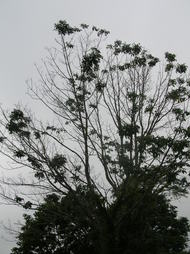 Diseases and Injuries
Ash Leaf and Twig Rust (Puccinia sparganioides) – Ash leaf rust, which can affect all species of native ash in Maine, was reported causing some moderate defoliation in Phippsburg, Maine (Sagadahoc County). It is likely to be found elsewhere along the mid and south-coastal regions, and may become more noticeable over the next several weeks. Look for bright yellow to orange spotting on the leaves and new green twigs. Cupping, twisting, and other deformations of the affected leaves and twigs will also be evident, and canker lesions may become evident. Extensive infections cause brown foliage and early leaf loss. Generally, ash leaf rust does not seriously threaten tree health. However, heavy infections can develop in some years, and severe defoliation over two or three successive years can result in crown dieback, tree decline, and occasionally in tree mortality.
Photo: White ash tree heavily defoliated from ash leaf rust, Thomaston, Maine. (Photo: W. Ostrofsky, MFS )
|
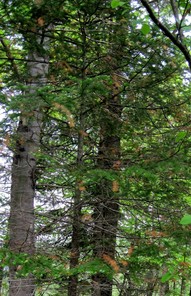 Balsam Fir Branch Dieback - We continue to receive numerous reports from throughout north-central, western, and southern Maine regarding balsam fir needle and branch tip damage. It seems to be more prevalent and conspicuous than it was in 2013, when it was first brought to our attention (see our Conditions Report for June, 2013). Reports this year have been from Phillips (Franklin County, The Forks (Somerset County), West Paris (Oxford County), Yarmouth (Cumberland County), points in between, and elsewhere. Some firs appear heavily affected, others have no damage. Symptoms are browning of needles on branches that appear randomly scattered throughout the affected tree crowns. We have found no insects or diseases associated with the damage, and hypothesize that weather conditions (most likely winter injury) triggered the needle/branchlet shedding, which became evident this spring with the arrival of warm weather. Although we have not been able to attribute any tree mortality directly to the dieback problem, we do observe the occasional balsam fir that has died from other causes – most commonly root and butt decay. It is expected that most trees will recover from the branch dieback.
Photo: Appearance of balsam fir branch dieback, Phillips, Maine. (Photo: W. Ostrofsky, MFS)
|
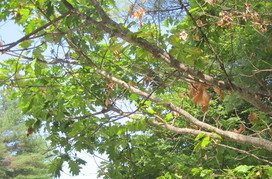 Oak Dieback – Symptoms of oak dieback have been observed in Standish (Cumberland County) and a few surrounding towns over the past month. Symptoms include the drying and death of leaves and branch tips, often with a clearly delimited canker separating the dead portion from the live portion of the branch. Leaves on affected branches become brown and persist on the tree, at least for several weeks. Occasionally, twigs of branches more proximal to the stem are affected first, rather than those at the branch tip itself. Diagnostic efforts have not yet assigned a cause, but the symptoms appear similar to those caused by infection from the canker disease pathogen, Botryosphaeria (Botyrosphaeria corticola = Diplodia corticola). This disease is generally considered to be a secondary agent, affecting trees initially weakened or damaged by some other cause. Until the causal agent is positively identified, the only recommendation for ornamental trees is to prune out and remove the affected branches from the point of healthy tissue, just beyond the extent of the canker. Anyone with oaks showing similar symptoms is encouraged to report the location and extent of the damage to the Maine Forest Service Insect and Disease Lab.
Photo: Oak dieback and symptoms, Standish, Maine. (Photo: W. Ostrofsky, MFS )
|
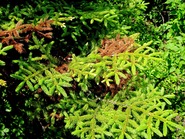 Winter Injury to Red Spruce – It seems odd to be discussing winter injury in July, but recent observations of red spruce at higher elevations (Johnson Mountain Township) revealed symptoms typical of freezing injury to foliage from this past winter. The phenomenon was intensively studied and documented during the 1980’s and 1990’s, when causes of spruce decline became the focus of climate change investigations. The damage, which includes the death and (usual) reddening of foliage, is the result of either a rapid freezing, or an especially deep freezing of the tissues. This is not the same damage that results from the more common wind-burn, or winter desiccation, and accounts for the significant difference in the pattern of damage on individual trees. The examined trees were of sapling size developing in even-aged stands with no overstory. Damage was considered moderate to light on most individual trees that had been affected, and is not considered to be a serious threat to tree survival.
Photo: Freezing injury to red spruce foliage, Johnson Mountain Township, Maine. (Photo: W. Ostrofsky, MFS )
|
Calendar
Forest Pest Outreach Training – The MeDACF Forest Pest Outreach Project and its partners are offering workshops to train people to recognize, report and spread awareness about the Asian longhorned beetle (ALB), emerald ash borer (EAB), and hemlock woolly adelgid (HWA) and other invasive tree pests. Three continuing education credits are available for licensed foresters and pesticide applicators; ½ day credit for Certified Logging Professionals. For more details see: www.maine.gov/alb under “What’s new?” in the right hand column. Registration requested—Contact Lorraine Taft at lorraine.taft@gmail.com or (207) 832-6241.
-
Wednesday, July 22, 2015; 12:00 PM - 4:30 PM; Hillgrove Community Hall, Rt. 1A, Whitneyville
-
Tuesday, August 25, 2015; 12:00 PM - 4:30 PM; University of Maine Farmington
-
Tuesday, September 15, 2015; TBD; York Co. (Location to be determined) Approved for the following education credits:
Maine BPC pesticide credits (3); SAF category 1 CFE/ME Lic. Forester (3); CLP (1/2 day)
Conditions Report No. 3, 2015
On-line: http://maine.gov/dacf/mfs/publications/condition_reports.html
Department of Agriculture Conservation & Forestry
Maine Forest Service - Forest Health and Monitoring
Contributors: Jeff Currier (Forest Protection), Allison Kanoti, William Ostrofsky, Colleen Teerling
|